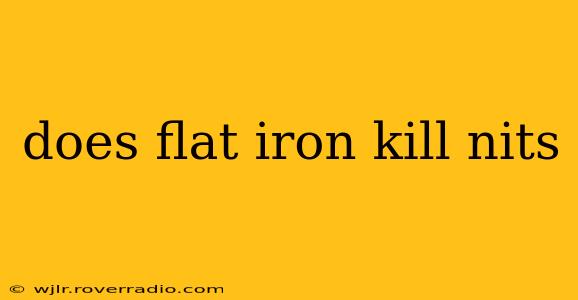Does a Flat Iron Kill Nits? The Truth About Heat and Head Lice
The question of whether a flat iron kills nits is a common one among parents and anyone dealing with a head lice infestation. While the high heat of a flat iron can kill lice, its effectiveness against nits (lice eggs) is significantly less certain and often unreliable. Let's delve into the details.
What is the difference between lice and nits?
It's crucial to understand the difference between lice and nits. Lice are the tiny, parasitic insects that infest the scalp and cause itching. Nits, on the other hand, are the eggs that lice lay. They are small, oval-shaped, and firmly attached to the hair shaft. This difference is key to understanding why a flat iron might be less effective against a full infestation.
Does a flat iron kill lice?
Yes, the intense heat from a flat iron (typically around 300-400°F or 150-200°C) can kill lice on contact. However, this requires direct and prolonged contact with each individual louse. Given the speed and agility of these insects, ensuring every single louse is exposed to the heat for a sufficient time is incredibly difficult.
Does a flat iron kill nits?
This is where the effectiveness of a flat iron becomes questionable. While high heat can kill nits, it requires significantly more time and direct exposure than it does for lice. The nit's tough outer shell provides a degree of protection against heat. Even if the heat does reach the nit, it needs to be sustained for a longer period to ensure the embryo inside is killed.
Moreover, the nits are often firmly attached to the hair shaft, making it difficult to maintain the necessary contact with the hot flat iron. Trying to achieve this thoroughness is time-consuming and could potentially damage hair.
What is the most effective way to get rid of lice and nits?
While a flat iron might offer some supplemental assistance, it's not a reliable primary method for treating head lice. The most effective approach involves a combination of methods:
- Lice combing: Using a fine-toothed lice comb to physically remove both lice and nits from the hair is crucial. This should be done systematically and repeatedly.
- Over-the-counter treatments: Several over-the-counter lice shampoos and lotions are available, containing permethrin or pyrethrin, which are insecticides that kill lice. Always follow the product instructions carefully.
- Professional treatment: In persistent or severe cases, seeking professional help from a doctor or a specialist is advisable. They may recommend stronger treatments or offer guidance on effective removal techniques.
Are there any risks associated with using a flat iron to kill lice and nits?
Using a flat iron on your hair to kill lice and nits carries risks:
- Hair damage: The intense heat can damage and break your hair, leading to dryness, split ends, and even hair loss.
- Scalp burns: Accidental contact with the hot plates of the flat iron can cause burns on the scalp.
- Ineffectiveness: As discussed, it's highly unlikely that a flat iron will completely eliminate lice and nits. Therefore, relying solely on this method could prolong the infestation.
In conclusion: While a flat iron might kill some lice and potentially some nits, it's not a reliable or recommended method for treating head lice. It's best to rely on proven and safe methods, such as meticulous combing and appropriate treatments, to effectively eliminate lice and nits and prevent reinfestation. If you have concerns about head lice, consult a healthcare professional or a specialist for advice and treatment options.
